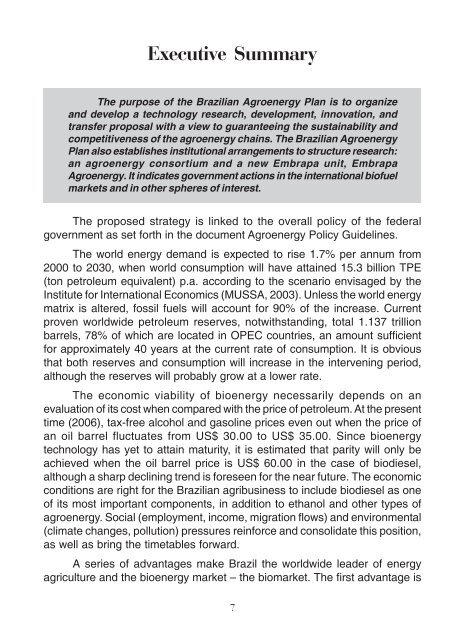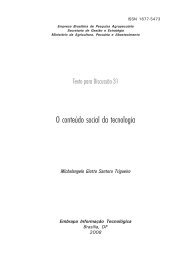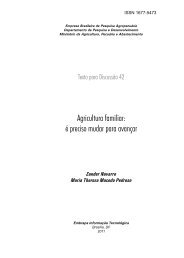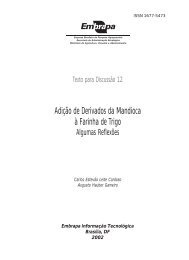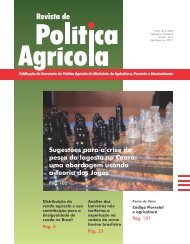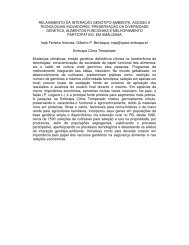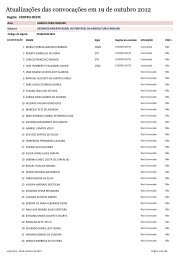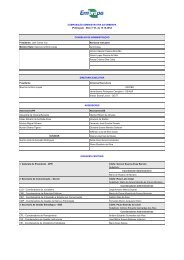Ministry of Agriculture, Livestock and Food Supply - Embrapa
Ministry of Agriculture, Livestock and Food Supply - Embrapa
Ministry of Agriculture, Livestock and Food Supply - Embrapa
You also want an ePaper? Increase the reach of your titles
YUMPU automatically turns print PDFs into web optimized ePapers that Google loves.
Executive Summary<br />
The purpose <strong>of</strong> the Brazilian Agroenergy Plan is to organize<br />
<strong>and</strong> develop a technology research, development, innovation, <strong>and</strong><br />
transfer proposal with a view to guaranteeing the sustainability <strong>and</strong><br />
competitiveness <strong>of</strong> the agroenergy chains. The Brazilian Agroenergy<br />
Plan also establishes institutional arrangements to structure research:<br />
an agroenergy consortium <strong>and</strong> a new <strong>Embrapa</strong> unit, <strong>Embrapa</strong><br />
Agroenergy. It indicates government actions in the international bi<strong>of</strong>uel<br />
markets <strong>and</strong> in other spheres <strong>of</strong> interest.<br />
The proposed strategy is linked to the overall policy <strong>of</strong> the federal<br />
government as set forth in the document Agroenergy Policy Guidelines.<br />
The world energy dem<strong>and</strong> is expected to rise 1.7% per annum from<br />
2000 to 2030, when world consumption will have attained 15.3 billion TPE<br />
(ton petroleum equivalent) p.a. according to the scenario envisaged by the<br />
Institute for International Economics (MUSSA, 2003). Unless the world energy<br />
matrix is altered, fossil fuels will account for 90% <strong>of</strong> the increase. Current<br />
proven worldwide petroleum reserves, notwithst<strong>and</strong>ing, total 1.137 trillion<br />
barrels, 78% <strong>of</strong> which are located in OPEC countries, an amount sufficient<br />
for approximately 40 years at the current rate <strong>of</strong> consumption. It is obvious<br />
that both reserves <strong>and</strong> consumption will increase in the intervening period,<br />
although the reserves will probably grow at a lower rate.<br />
The economic viability <strong>of</strong> bioenergy necessarily depends on an<br />
evaluation <strong>of</strong> its cost when compared with the price <strong>of</strong> petroleum. At the present<br />
time (2006), tax-free alcohol <strong>and</strong> gasoline prices even out when the price <strong>of</strong><br />
an oil barrel fluctuates from US$ 30.00 to US$ 35.00. Since bioenergy<br />
technology has yet to attain maturity, it is estimated that parity will only be<br />
achieved when the oil barrel price is US$ 60.00 in the case <strong>of</strong> biodiesel,<br />
although a sharp declining trend is foreseen for the near future. The economic<br />
conditions are right for the Brazilian agribusiness to include biodiesel as one<br />
<strong>of</strong> its most important components, in addition to ethanol <strong>and</strong> other types <strong>of</strong><br />
agroenergy. Social (employment, income, migration flows) <strong>and</strong> environmental<br />
(climate changes, pollution) pressures reinforce <strong>and</strong> consolidate this position,<br />
as well as bring the timetables forward.<br />
A series <strong>of</strong> advantages make Brazil the worldwide leader <strong>of</strong> energy<br />
agriculture <strong>and</strong> the bioenergy market – the biomarket. The first advantage is<br />
7


